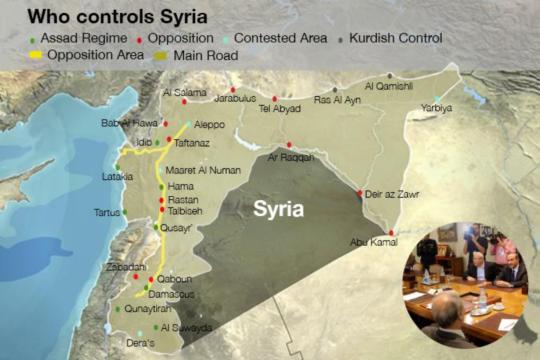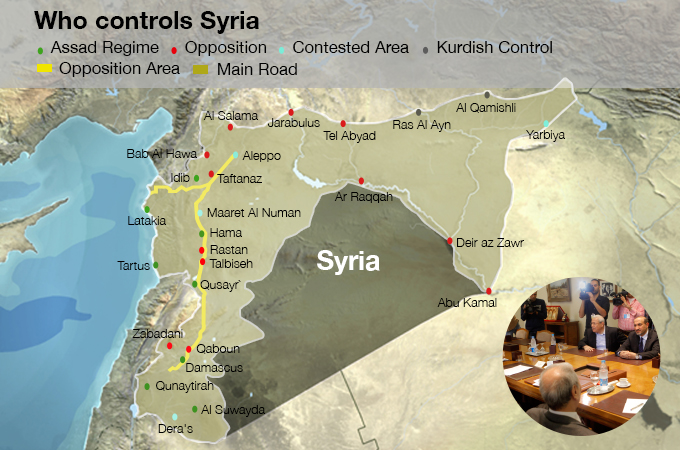
 |
| [AlJazeera] |
| Abstract The Syrian revolution’s landscape, with several centers of political and military power rather than one unified center, seems to be accelerating towards a breakdown. A number of factors, including the path towards Geneva II, lukewarm US-Saudi ties, wider differences between the internal and external opposition and the formation of the Syrian Islamic Front, have contributed to this impending breakdown. If the opposition is able to form an interim government despite considerable uncertainties as well as despite the necessary link with and responsibility to the National Coalition of Syrian Revolution and Opposition Forces, it will provide a great opportunity to strengthen the relationship between internal opposition groups and those abroad. The most urgent challenge to the Syrian revolution today is enhancing confidence of all political and military powers in such a way that consensus is built on all levels. Anything short of that will render the revolution (militarily and politically) even more vulnerable to the changing winds around it. |
Introduction
This paper serves as a discussion of the developments of the Syrian revolution from the National Coalition of Syrian Revolution and Opposition Forces’ perspective and the challenges it continues to face as 2013 comes to a close. Since its inception in Doha in November 2012, the Coalition has managed to attract new forces and figures with a wide variety of Syrian groups, parties and personalities. It has been recognized and joined by the Kurdish National Council, members of the General Command of the Free Syrian Army (FSA) and even a group of countries supporting the Syrian revolution and calling themselves the Friends of Syria, including the United States and major European and Arab players.
However, while the coalition has been able to earn international recognition for its iconic role against the Assad regime, the Coalition faces a number of challenges which put its future at state. The key issue at the moment is its choice of attending Geneva II and how to handle risks arising from the conference. The Syrian Islamic Front’s formation as a major armed faction and the Coalition’s struggle to form an interim government are two other major challenges which will be discussed in this paper.
Geneva II: necessity with risks
US Secretary of State John Kerry met Russian Foreign Minister Sergei Lavrov in May 2013 to follow up on Geneva I held in June 2012. In the May 2013 meeting, the two parties agreed to hold a conference, now known as Geneva II, bringing together representatives of the regime and opposition. The conference presents challenges for both sides – challenges complicated by the vague nature of the Geneva I outcomes that did not even clearly identify either side.
The conference was initially set for November, but the lack of acceptance by all relevant parties delayed the meeting. The National Coalition fears it would find itself forced to accept partners they deem unworthy, while the regime fears the conference could be a prelude to a US-Russia deal at its expense. Iran and Saudi Arabia, both in the region, fear the conference as well. Iran worries it will be excluded from the conference while Saudi Arabia is hesitant to attend given the US’ recent foreign policy decisions.
As time has gone on, prospects for the conference have improved, particularly in light of Russia’s pressure on Assad and US and western pressure on the Coalition. During the October 22, 2013 Friends of Syria meeting, the opposition was given an incentive to attend when the Friends released a statement that the Syrian president should not have a role in the transitional government.
The Coalition in particular has been under pressure from various actors to make a decision regarding Geneva II. The US wants them to attend, while Saudi Arabia is recommending they delay any decisions until the last possible moment. After a stormy opposition meeting in Istanbul on November 11, 2013, the Coalition announced its conditional participation in the conference, stipulating that Iran be excluded and calling for humanitarian corridors to be opened in order to reach areas besieged by the regime in the Damascus countryside and the Homs and Hama provinces, as well as the release of political prisoners and international support for rebels on the ground fighting regime forces and their foreign military allies.
The opposition and regime’s hesitance have not deterred the international community’s insistence on holding Geneva II. UN Secretary General Ban Ki-moon has announced the new date for the conference will be mid-January 2014 and instructed UN envoy to Syria Lakhdar Brahimi to begin preparations for it. As the date nears, however, it is clear the situation will only become more complicated – the opposition still has to fortify its position without losing the international community’s backing, the conditions it set for the conference cannot and will not be achieved, it is not yet clear what Assad’s role will be during the transitional phase or who will represent the regime during the conference, and Brahimi has yet to announce whether or not the Coalition will be the sole representative of the opposition at the conference.
Opposition government’s challenges
The Coalition has seen a number of milestones in the past few months. Representatives from the Kurdish National Council were added during the latest meeting in Istanbul, bringing the general assembly to 122 members. Ahmad Ta’meh al-Khadr was announced as head of the interim government on November 13, 2013, ending a months-long stalemate over the choice of a candidate. In July 2013, pro-Saudi Arabia Ahmed Jarba was elected as president of the coalition while Ghassan Hitto put forth his resignation as leader of the coalition. The July 2013 meeting was significant given the reconciliatory atmosphere created between the three most supportive countries of the revolution: Turkey, Saudi Arabia and Qatar. Finally, the meeting ended with the selection of all ministers with the exception of the interior, health and education ministers.
For the Coalition, the July meeting was indicative that it was possible to achieve agreement swiftly and move towards forming a government whose chairman and members enjoy the confidence of the majority. However, many risks lie in the Coalition’s path, including security risks threatening liberated areas of Syria and limiting the public appearance of ministers among the people. The liberated areas are controlled by several armed groups rather than one single command, and while they fall under the Free Syrian Army’s umbrella, the majority work independently of FSA’s leadership, complicating security risks. Any interim government is subjected to the consent of all of these factions if they attempt to manage liberated areas. Finally, the government suffers from a severe lack of funds – even after a month of formation, the only public announcement of funds has been Saudi Arabia’s $300 million pledge to the Coalition.
New power: Syrian Islamic Front
A surprise announcement on November 22, 2013 introduced the Syrian Islamic Front (SIF), an agreement between seven of the strongest Islamist factions to unify armed factions. The group consists of Liwa at-Tawheed, Ahrar ash-Shaam, the Islamic Army, Suqoor ash-Shaam, Liwa al-Haqq, Ansar al-Islam and the Kurdish Islamic Front. Two things are significant about the formation – first that Kurdish Islamist fighters chose to join the front rather than any nationalist Kurdish groups, and second that the SIF has distanced itself from the Islamic State of Iraq and the Levant (ISIL, also known as ISIS) and the Nusra Front. The ISIL’s behavior has triggered much controversy and the Nusra Front is affiliated with al-Qaeda, although its stances are more moderate than ISIL.
Previous attempts at unification have not lasted long, but the SIF project seems to be more serious given the environment in which it was created. Its formation came at a time when armed Islamic factions sensed that regional and international efforts were being directed to build, train and equip special forces affiliated with the Free Syrian Army (FSA) in order to control liberated areas as well as serve as the nucleus of the Syrian military after the regime falls. Part of the role of the special forces would be to eliminate armed Islamic groups. The SIF was also created in a decentralized stage of the armed opposition, with most factions formed locally and rampant differences in ideologies and financial backers for these local factions.
SIF’s formation makes a political as well as a military statement – meaning that it is very well possible the opposition, namely the Coalition, may find itself with yet another rival wishing to represent the revolution and opposition forces. Unconfirmed reports that SIF has completely severed ties with the FSA’s General Command only serve to confirm its position as a possible political actor. A group from SIF took over the vital Bab al-Hawa border crossing and the FSA General Command’s ammunition stores in the area the first week of December 2013, illustrating the SIF’s large capabilities in northern Syria, compounded by their control over most of the Aleppo and Idlib provinces.
Battle for consensus
The fighting on several fronts has not yet created a critical military situation for the Syrian revolution, but it is becoming more difficult for the opposition to battle the steady flow of Hezbollah and other foreign fighters into Syria to fight alongside the Assad regime’s army. Regime forces and their allies have made strides into the Qalamoun Valley region during November and December 2013, but the rebels continue to control most of the Deir ez-Zor, ar-Raqqah, al-Hasakah, Aleppo, Idlib and Deraa provinces. Many of the battles do not have a clear winner, with victories turning into losses within hours.
This paper has discussed the National Coalition of Syrian Revolution and Opposition Forces’ considerations in terms of Geneva 2 and the possibility that it will not be able to influence the course of the meeting given the large magnitude of differences, concerns and mutual suspicion, particularly with the formation of a new military unit, the Syrian Islamic Front.
Successfully forming an interim government despite uncertainty may provide a great opportunity to strengthen ties between internal and external opposition groups, but the greatest challenge facing the Syrian revolution today is for the Coalition to find a way to enhance the confidence of all political and military actors and build consensus at all levels. Anything short of that will leave the revolution, militarily and politically, at great risk and subject to the constantly-shifting environment around it.